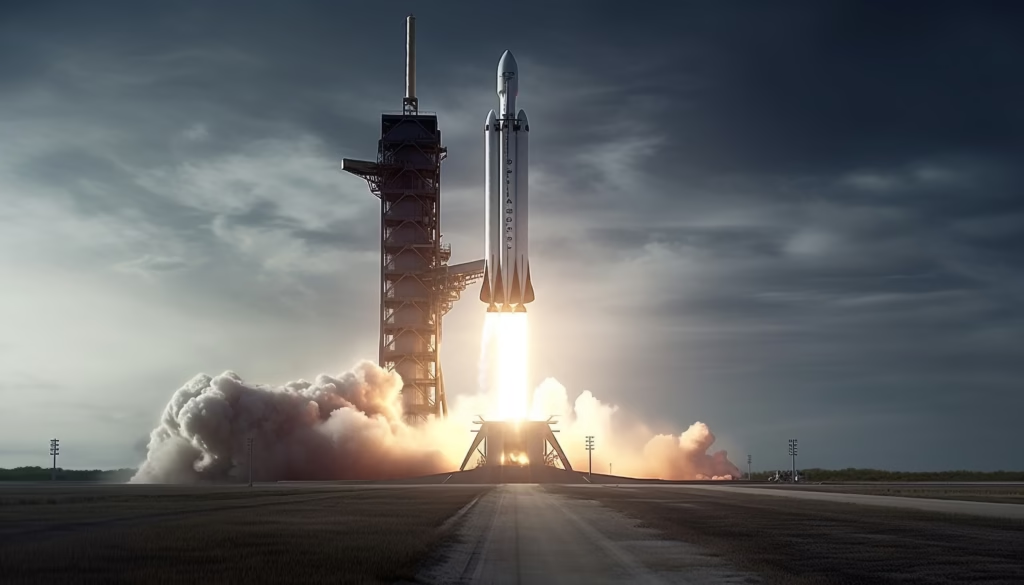Introduction
Imagine if launching into space became as easy as booking a trip across the ocean. It used to be just a dream, but by 2025, SpaceX is making it a reality. SpaceX is not only building rockets but also transforming space travel with upright landings, satellite internet, and live super-rocket tests.
In this guide, we’ll dive into the current state of SpaceX. We’ll look at how they dominate the market, the risks they take, and the challenges they face. Whether you’re a science fan or just curious about the news, this is your quick rundown.
Table of Contents
The 2025 snapshot: A company of escape velocity
By the middle of 2025, SpaceX is clearly the biggest player in the launch game worldwide. In 2024, they launched 134 Falcon rockets, making up more than half of all global orbital launches. So far this year, they’ve already had over 80 launches and aim for 170 by the end of the year. This isn’t just dominance; it’s like they’ve got a monopoly on the launch pace.
Starlink, their internet service, has more than 6 million subscribers globally. With their launch services, they manage the biggest satellite fleet ever. This fleet includes over 6,750 satellites. Add a jaw-dropping valuation of almost $400 billion, and SpaceX is more than just a rocket company; it’s a whole ecosystem. They’re like a freight train laying down tracks as they go, working on multiple projects at once.
Falcon 9 & Falcon heavy: The Workhorses
The Falcon 9 is like the Boeing 737 of rocketry—efficient, powerful, and reusable. Its big brother, Falcon Heavy, is like a triple-engine pickup truck that can carry eight tons.
What really sets the Falcon rockets apart is that they can be reused. Some boosters have flown 25 to 30 times, with wait times as short as nine days between flights. Imagine if all commercial planes were retired after one use—that was the reality before Falcon came along. Reusing the same boosters has brought down launch costs and allowed for a more regular schedule.
This idea of reusability not only saves money; it also gives customers peace of mind. They know their satellites won’t sit around waiting for months to get launched.
What is Reuse (in everyday terms)?
- Booster: Think of it like the bottom part of a firework that comes back down the right way up and is used again for the next show.
- Fairings: These are the protective shells at the top of the rocket. SpaceX retrieves them from the ocean, cleans them up, and uses them again.
- Turnaround time: That quick nine-day turnaround for boosters is like a NASCAR pit crew but for rockets—fast, precise, and totally repeatable.
Dragon and the Age of Human Spaceflight

SpaceX’s Crew Dragon is America’s space taxi. In May 2020, it marked the return of U.S. astronauts to orbit since the Shuttle program ended. Crew-10 successfully completed its mission to the ISS in August 2025, proving that this service is both reliable and essential.
For NASA, Dragon isn’t just a prototype; it’s a key part of their infrastructure. This means SpaceX can fly humans into space just like they do with satellites.
Starlink: SpaceX’s Global Internet Network
While the Falcon rockets are moving things forward, Starlink is what keeps the engine running. What started as an experiment is now a money-making service with millions of users across six continents. Operating in low Earth orbit, Starlink provides internet speeds that rival fiber optics. It covers areas from ocean-bound ships to remote communities.
Of course, no system is perfect. A big outage in July 2025 showed just how tricky it can be to manage such a vast network. Still, Starlink is now the world’s biggest satellite-based internet provider.
Starship: The Giant Leap Forward

If Falcon 9 is a dependable truck, then Starship is like a giant cargo ship. It is a two-stage rocket taller than the Statue of Liberty! This initiative is engineered for substantial lifting capacity. It is designed for total reusability. It seeks to turn ambitious space endeavors, such as orbital stations and lunar bases, from mere possibilities into tangible realities. This is achieved by drastically reducing launch expenses.
Test flights have had their ups and downs, but each one has been a valuable learning experience. Notably, Flight 10 managed to splash down after deploying test satellites in August 2025. This was a key milestone. Each setback paves the way for progress. If SpaceX nails it with Starship, it could change how we access space and explore our solar system.
Raptor Engines: Powerhouse Beneath Steel
Every launch relies on clusters of Raptor engines powered by liquid methane and oxygen. It’s a significant engineering accomplishment, pushing jet propulsion to new heights for skyscraper-sized rockets. These engines are designed for maximum efficiency while using propellants—an impressive feat that not many companies can pull off. Methane was chosen because it burns cleaner than traditional fuels. Importantly, it has the potential to be produced on Mars one day. This means SpaceX is thinking ahead about making space travel sustainable.
NASA Artemis & Lunar Goals
NASA plans to use SpaceX’s modified Starship for the Artemis program to return humans to the Moon. Astronauts will travel using an Orion capsule before hopping onto landers built on proven commercial tech. Timelines keep shifting, with the first crewed landing facing delays due to technical challenges, like developing heat shield technology. For SpaceX, Artemis represents more than just a contract. It is crucial support for developing technology needed to eventually explore Mars.
National Security Initiatives & “Starshield”
SpaceX is doing some pretty cool stuff these days, and it’s not just about making money. In April 2025, they secured major defense contracts worth billions by collaborating with the government on national security launches. They’re also working on special programs called ‘Starshield.’ While we don’t know all the details since they’re kept under wraps, think about consumer networks. They have extra protection to keep things safe for the government. These networks use really strong encryption to secure communications when they’re needed the most.
Reusable Rockets Transform Economics
The idea behind reusable rockets is straightforward. It is a smart strategy. Every time a rocket is flown again instead of being thrown away, it saves a bunch of money in the long run. Just look at the Falcon rockets; they’ve flown multiple times and have shown this works! New technology is on the way promising even more advancements. As a result, we’re starting to move away from the days of one-and-done rockets. This shift is making it way more affordable to launch things into space. This opens up a lot of exciting possibilities for the whole space industry!
Risks and Obstacles
But it’s not all smooth sailing for SpaceX. They face some serious challenges:
- Fleet reliability: Rockets that get reused 25-30 times need to be really safe, not just look good on paper. this approach comes at a high cost—and aerospace leaves little room for error.
- Regulatory slowdowns: The FAA can slow things down with testing if there are hiccups.
- Technical issues: The heat shield on Starship has to withstand intense temperatures when it re-enters the atmosphere.
- Operational pressures: Problems with the Starlink network show that managing tech is just as crucial as building rockets.
SpaceX is great at making quick changes, but in aerospace, there’s not a lot of room for mistakes.
Culture Shift—Redefining Aerospace Norms
One of SpaceX’s biggest impacts isn’t just about tech; it’s really about changing the culture. They’ve brought that “move fast and break things” vibe from Silicon Valley into a field that’s usually pretty careful. Instead of waiting years for research, they dive right in. They build fast and fly often. They even fail out in the open to learn quicker.
This new approach has transformed wild ideas into reality. Concepts like catching rockets with robotic arms are now feasible. Launching them as regular flights is also achievable. SpaceX is moving space travel from large projects to practical experiments, expanding their “garage” significantly!
What Lies Ahead Over the Next Year
So, what should we look forward to in the coming year?
- Will they hit over thirty successful booster missions?
- Can they recover Starship intact?
- How soon can we count on reliable orbital refueling?
- Will Starlink see massive growth, or will there be new regulations?
- Will NASA stick to Artemis timelines through 2027?
The answers to these questions will shape how we move forward into space.
Looking Forward
Right now, SpaceX is kind of a contradiction—a startup vibe in the world’s biggest launch company. They produce rockets rapidly like an assembly line. They launch many satellites at once. They also conduct tests quickly and on an unprecedented scale.
The impact of all this is huge. Falcon rockets have greatly reduced costs, making space travel more accessible. Starlink provides internet globally. With Starship set for deep-space missions, they aim to transform how humanity lives and works in space.
Watching SpaceX is witnessing history in real-time for science enthusiasts and trend watchers. Keep an eye on flight schedules, Starship news, and Artemis updates—each event brings us closer to our future in space!
Discover more from NewsBusters
Subscribe to get the latest posts sent to your email.

2 thoughts on “SpaceX in 2025: The Rocket Company Which Made The Science Fiction Realities”